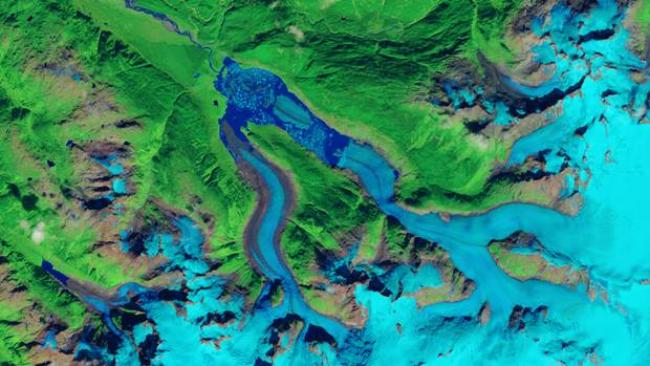Articles Menu

A massive chunk of ice – thought to be the largest iceberg to ever break off a glacier in Canada – fell into a lake in British Columbia this summer and no one noticed until a U.S. scientist saw it on a NASA photo.
Dr. Mauri Pelto, professor of environmental science at Nichols College in Massachusetts and director of the North Cascade Glacier Climate Project for more than 25 years, said the Porcupine Glacier retreated nearly two kilometres in one leap when the iceberg broke off.

“Looking back at some of the other work I’ve done in Alaska and British Columbia, I could not find an example of a bigger iceberg,” he said in an interview Wednesday. “There are some that are comparable [in Alaska], so I don’t want to jump up and down and say it’s the absolute biggest – but certainly it is the largest iceberg I’ve ever seen in Canada.”
The 1.2-square-km iceberg calved from the tongue of the glacier in northwest B.C. in late summer. It was photographed when a NASA Earth Observations (NEO) satellite passed over the remote region on Aug. 27.
Earth Observatory, an online publishing site for NEO, posted it as its planetary image of the day on Wednesday.
Dr. Pelto, who has been analyzing satellite imagery of glaciers in the region since the 1980s, said the Porcupine Glacier event is part of a broader trend in which glaciers are retreating rapidly.
“The volume loss has been speeding up in these glaciers,” he said.
Typically, a glacier calves numerous small icebergs as it retreats. But Dr. Pelto said a very large chunk of ice broke off in the Porcupine case because of rapid melting both on top of and underneath the glacier’s tongue, which is floating on a lake of melted ice.
“I knew it would be a good time to look at the glacier,” he said of his decision to examine the NEO photos. “I hadn’t looked in maybe two years at the satellite imagery at the end of [the tongue], and it looked poised for a breakup. So I looked. I was just expecting to see a decent retreat of the glacier and, of course as it happened, what was unusual was just the size of the iceberg that calved off there.”
Dr. Pelto said the Porcupine iceberg is a dramatic reminder that glaciers are in such rapid retreat because of climate change.
“It’s just a highlight example of what’s happening,” Dr. Pelto said. “I could list 100 glaciers that are doing a similar thing in terms of the rate of retreat in the last 20 years, that are within a couple hundred miles of that location. And so it is just one example.”
Porcupine Glacier is located about 70 kilometres northeast of Wrangell, Alaska, in an area where the snow-capped mountain ranges are laced with icefields.
But even in that northern latitude, glaciers are undeniably feeling the heat of climate change, Dr. Pelto said. “I have worked on over 200 glaciers just in that area, and all but one have been retreating.”
He said many glaciers in B.C. are expected to vanish quickly, while others, which are fed by high snowfields, will last longer.
“It’s hard for me to forecast the climate going forward, but it’s not going to get better for the glaciers,” he said. “In Garibaldi Park [90 km north of Vancouver], you see glaciers like the Helm that don’t retain snow pack any more. So that glacier is going to disappear with the current climate.”
One sign of the rapid change taking place is the formation of new lakes at the foot of melting glaciers.
He said the Shatter and Shudder glaciers near Whistler now have small lakes below them, while others, such as the Porcupine and the Freshfield Glacier, in the Rocky Mountains north of Lake Louise, have formed large lakes.
Dr. Pelto said that, although the Porcupine Glacier took a huge jump this year, he doesn’t expect it will continue to retreat as rapidly. As it melts over the next few years, the tongue of the Porcupine will move up a slope from the lake, where it will come to rest on bedrock rather than on water, he said
“The rate of the retreat may actually decline in the case of Porcupine when it reaches the head of the lake. But as our other examples from the region have shown, just because you reach the end of the lake it doesn’t mean you stop retreating. You still continue to retreat, it’s just not as fast.”
[Top photo: A satellite photo from NASA shows Porcupine Glacier in northern B.C. after a 1.2-square-kilometre chunk of ice broke off into a record-breaking glacier.
(NASA)]